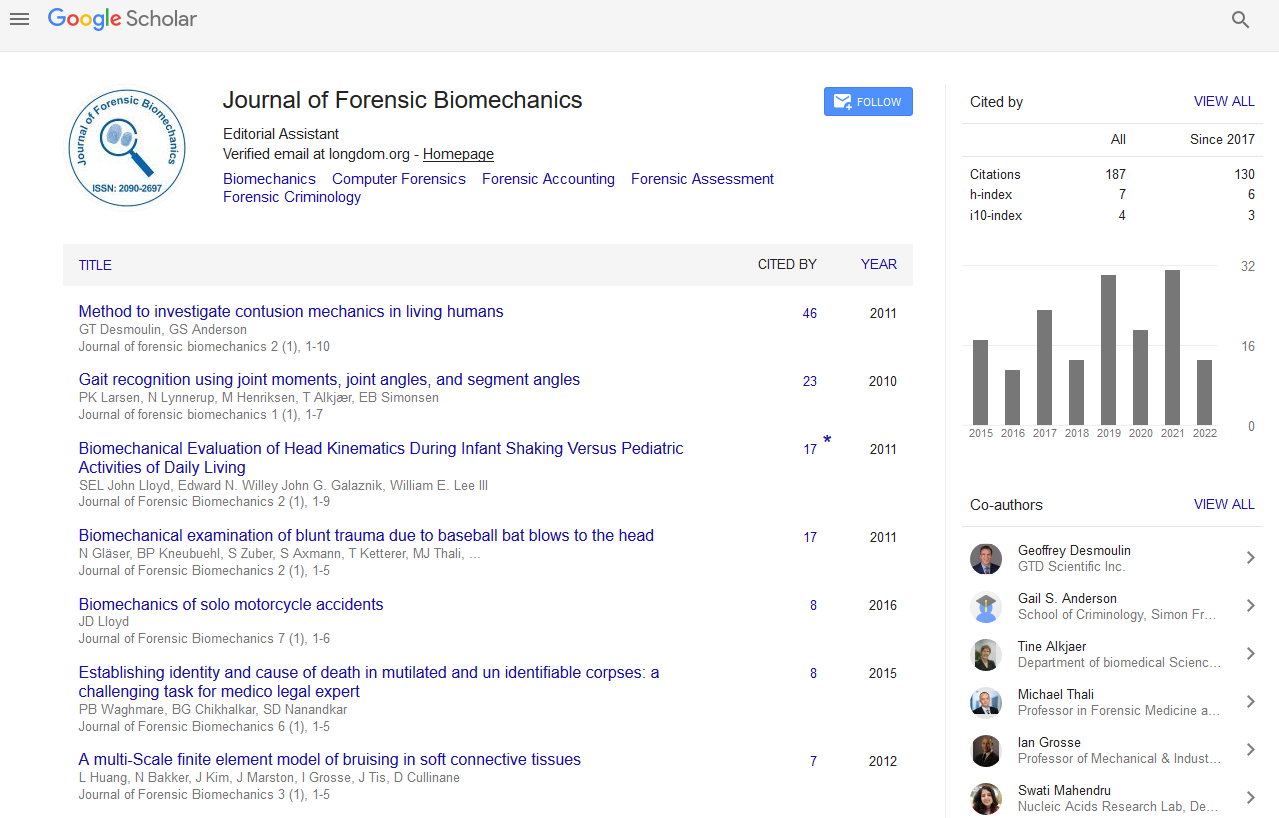Indexed In
- Genamics JournalSeek
- SafetyLit
- Ulrich's Periodicals Directory
- RefSeek
- Hamdard University
- EBSCO A-Z
- Geneva Foundation for Medical Education and Research
- Euro Pub
- Google Scholar
Useful Links
Share This Page
Journal Flyer

Open Access Journals
- Agri and Aquaculture
- Biochemistry
- Bioinformatics & Systems Biology
- Business & Management
- Chemistry
- Clinical Sciences
- Engineering
- Food & Nutrition
- General Science
- Genetics & Molecular Biology
- Immunology & Microbiology
- Medical Sciences
- Neuroscience & Psychology
- Nursing & Health Care
- Pharmaceutical Sciences
Perspective - (2024) Volume 15, Issue 4
The Role of Biomechanics in Analyzing Force and Injury in Forensic Cases
Charles Adams*Received: 28-Nov-2024, Manuscript No. JFB-24-27904; Editor assigned: 02-Dec-2024, Pre QC No. JFB-24-27904 (PQ); Reviewed: 16-Dec-2024, QC No. JFB-24-27904; Revised: 23-Dec-2024, Manuscript No. JFB-24-27904 (R); Published: 30-Dec-2024, DOI: 10.35248/2090-2697.24.15.504
Description
Biomechanics plays a key role in understanding the forces that contribute to injury patterns particularly in the context of forensic investigations. The human body when subjected to various forces such as impact acceleration or compression responds in ways that can provide vital clues to investigators. By analyzing the forces acting on the body during an incident forensic biomechanics helps reconstruct the events that led to injury and can offer invaluable insights into the nature and severity of trauma. At the core of biomechanics is the study of motion and the forces that cause movement. Every injury whether from a car crash slip and fall or assault can be traced back to the forces applied to the body. These forces may include impacts rotational movement’s gravitational forces or the interaction of the body with external objects or surfaces. Forensic biomechanists examine how these forces act on different parts of the body and how they contribute to the injury patterns observed. This scientific analysis enables them to reconstruct the sequence of events leading to an injury offering a clearer understanding of how the body was affected. One of the primary aspects of forensic biomechanics understands the magnitude and direction of forces involved in the injury. The body’s tissues such as bones muscles and ligaments have varying thresholds for tolerance to force. When a force exceeds these thresholds it leads to injury.
For instance in a car accident the body may experience rapid checking forces that can lead to whiplash or spinal injuries. Similarly a fall from a height may cause fractures depending on the force exerted upon impact with the ground. By applying principles of physics forensic biomechanists can calculate the forces involved in these scenarios allowing them to determine the likelihood of certain injuries based on the circumstances. Another critical aspect of biomechanics in injury analysis is the understanding of the body’s response to different types of forces. For example blunt force trauma such as being struck by a heavy object creates different injury patterns than penetrating trauma such as a stab wound. When the body is subjected to a blunt force the energy from the impact is transferred through the skin muscles and bones. This can cause contusions fractures or internal injuries depending on the nature and location of the impact. On the other hand a penetrating force can cause localized damage to tissues organs or blood vessels often leading to more specific injury patterns. By studying the mechanics behind these forces forensic biomechanists can differentiate between the two types of trauma and provide more accurate conclusions about the cause of injury.
The role of biomechanics is particularly evident in cases involving vehicle collisions where speed direction and the type of crash all contribute to the injury patterns observed. In a rear-end collision for example the occupants of the vehicle may experience forces that cause their heads to snap back and forth resulting in whiplash injuries. By analyzing the forces generated during the collision biomechanists can assess the severity of the impact and predict the types of injuries that might result. They can also determine whether the injuries were consistent with the scenario described by the individuals involved or if the injury patterns suggest a different sequence of events.
In addition to impact-related injuries forensic biomechanics is also instrumental in understanding repetitive stress injuries or those caused by prolonged exposure to certain forces. For example in cases of occupational injuries repetitive motions or improper body mechanics over time can lead to musculoskeletal disorders. By analyzing the forces involved in these repetitive actions biomechanics can help identify the specific motions or positions that contribute to injury providing critical information for both prevention and legal evaluation. Forensic biomechanics often uses advanced technologies and models to simulate and analyze these forces.
Computer simulations crash test dummies and motion analysis systems allow experts to recreate accident scenarios in a controlled environment providing a more detailed understanding of how forces act on the human body. These technologies enable the creation of accurate injury models which can then be compared to real-life injury patterns observed in forensic cases. Ultimately the ability to decode injury patterns through biomechanics is a powerful tool in forensic science. By understanding the forces at play during an incident forensic biomechanists can reconstruct accidents identify potential causes of injury and provide objective scientifically-backed evidence for legal cases. This method of analysis is particularly valuable in personal injury charges criminal investigations and insurance claims where precise and reliable information is essential. By bridging the gap between science and the legal system forensic biomechanics helps ensure that the right cause of injury is revealed and reasonableness is work.
Citation: Adams C (2024). The Role of Biomechanics in Analyzing Force and Injury in Forensic Cases. J Forensic Biomech. 15:504.
Copyright: © 2024 Adams C. This is an open-access article distributed under the terms of the Creative Commons Attribution License, which permits unrestricted use, distribution, and reproduction in any medium, provided the original author and source are credited

